-
 Bitcoin
Bitcoin $107,631.9817
-1.73% -
 Ethereum
Ethereum $2,739.1787
-4.61% -
 Tether USDt
Tether USDt $1.0000
-0.01% -
 XRP
XRP $2.2427
-3.30% -
 BNB
BNB $664.0527
-0.73% -
 Solana
Solana $158.0902
-5.38% -
 USDC
USDC $0.9998
-0.01% -
 Dogecoin
Dogecoin $0.1876
-7.78% -
 TRON
TRON $0.2753
-3.21% -
 Cardano
Cardano $0.6820
-5.55% -
 Hyperliquid
Hyperliquid $43.0171
-0.38% -
 Sui
Sui $3.3308
-4.87% -
 Chainlink
Chainlink $14.3431
-7.89% -
 Avalanche
Avalanche $21.0266
-6.48% -
 Bitcoin Cash
Bitcoin Cash $437.7657
-1.56% -
 Stellar
Stellar $0.2746
-2.52% -
 UNUS SED LEO
UNUS SED LEO $8.8665
-1.96% -
 Toncoin
Toncoin $3.1885
-3.37% -
 Shiba Inu
Shiba Inu $0.0...01260
-6.84% -
 Hedera
Hedera $0.1686
-4.93% -
 Litecoin
Litecoin $88.8406
-5.16% -
 Polkadot
Polkadot $4.0542
-6.28% -
 Monero
Monero $322.5806
-4.20% -
 Ethena USDe
Ethena USDe $1.0004
-0.02% -
 Bitget Token
Bitget Token $4.7089
-3.10% -
 Dai
Dai $0.9998
-0.01% -
 Pepe
Pepe $0.0...01206
-9.06% -
 Uniswap
Uniswap $7.8694
-5.20% -
 Pi
Pi $0.6232
-2.68% -
 Aave
Aave $301.3815
-3.83%
Exodus transaction is stuck in the verification stage. Can restarting the wallet solve it?
Restarting Exodus may help a stuck transaction by resyncing the wallet, but it's not a guaranteed fix; network issues or low fees might still cause delays.
May 15, 2025 at 11:49 pm
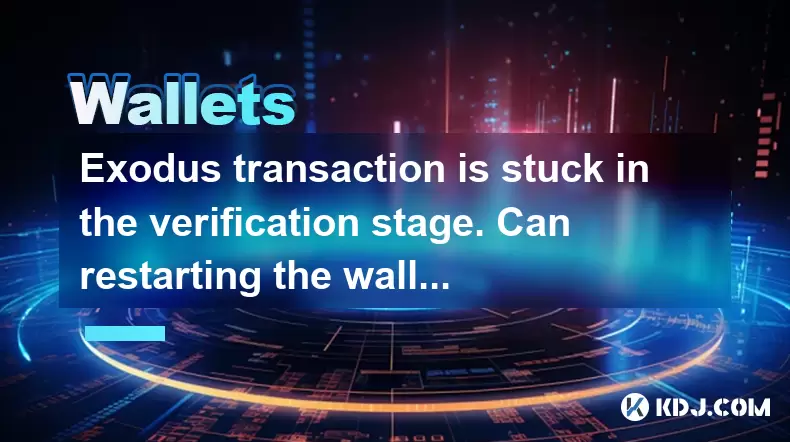
When an Exodus transaction remains stuck in the verification stage, it can be a frustrating experience for any user. The question of whether restarting the wallet can solve this issue is a common one, and the answer involves understanding the underlying processes and potential solutions. In this article, we will explore the reasons behind a stuck transaction, the role of restarting the wallet, and other possible solutions to resolve the issue.
Understanding Transaction Verification in Exodus
Transaction verification in the context of cryptocurrencies like Bitcoin, Ethereum, and others involves several steps to ensure the transaction is valid and can be added to the blockchain. When you initiate a transaction in Exodus, it is broadcast to the network, where it waits to be picked up by miners or validators. The verification stage is crucial because it confirms that the transaction adheres to the rules of the blockchain, such as having the correct signatures and sufficient funds.
If a transaction remains stuck in the verification stage, it typically means that it has not yet been confirmed by the necessary number of nodes on the network. This can happen due to various reasons, including network congestion, low transaction fees, or issues with the transaction data itself.
Can Restarting the Wallet Help?
Restarting the wallet might help in some cases, but it is not a guaranteed solution. Here’s why:
Wallet Syncing: When you restart Exodus, it will resync with the blockchain. This can sometimes help if the wallet was out of sync, causing a delay in transaction verification. However, if the issue is with the transaction itself or the network, restarting may not make a difference.
Connection Issues: If the wallet was experiencing connectivity issues, restarting might re-establish a stable connection to the network, potentially allowing the transaction to proceed.
Software Bugs: Occasionally, a software glitch within the wallet could prevent transactions from being broadcast correctly. Restarting can sometimes resolve such temporary bugs.
However, if the transaction is stuck due to reasons beyond the wallet's control, such as network congestion or insufficient transaction fees, restarting the wallet will not resolve the issue.
Other Solutions to Try
If restarting the wallet does not resolve the stuck transaction, there are several other steps you can take:
Check Transaction Fee: If the transaction fee was set too low, it might not be attractive enough for miners to prioritize it. You can try to increase the fee by using the Replace-By-Fee (RBF) feature if the transaction supports it. To do this:
- Open Exodus and navigate to the transaction history.
- Find the stuck transaction and look for the option to increase the fee.
- Follow the prompts to adjust the fee and resend the transaction.
Wait for Network Congestion to Clear: Sometimes, the blockchain network might be experiencing high traffic, leading to delays. Waiting for the congestion to clear can sometimes resolve the issue naturally.
Contact Exodus Support: If the above steps do not work, reaching out to Exodus's customer support can provide additional guidance. They can help diagnose the issue and suggest further steps tailored to your specific situation.
Use a Blockchain Explorer: You can use a blockchain explorer to check the status of your transaction. This can provide more insight into why the transaction might be stuck. To do this:
- Copy the transaction ID from Exodus.
- Paste it into a blockchain explorer like Blockchain.com or Etherscan.
- Review the transaction details to see if it has been broadcast but not confirmed, or if there are any errors.
Preventing Future Transaction Issues
To minimize the chances of future transactions getting stuck, consider the following best practices:
Set Appropriate Fees: Always ensure that the transaction fee is set appropriately based on current network conditions. Tools like fee estimators can help you determine the optimal fee.
Keep Software Updated: Regularly update your wallet software to the latest version to benefit from bug fixes and performance improvements.
Monitor Network Conditions: Before sending a transaction, check the current state of the blockchain network. High congestion periods can lead to delays, so timing your transactions can be beneficial.
Double-Check Transaction Details: Ensure all transaction details, including the recipient address and amount, are correct before sending. Errors in these details can lead to stuck transactions.
Additional Considerations
It's important to understand that while Exodus provides a user-friendly interface, the underlying blockchain technology can be complex and unpredictable. Factors such as blockchain forks, changes in network protocols, or even issues with the wallet's connection to the internet can impact transaction processing.
In some cases, transactions might remain stuck for an extended period, and you may need to wait for the transaction to either be confirmed or dropped by the network. If a transaction is dropped, the funds should return to your wallet, but this can take time.
FAQs
Q1: How long should I wait before taking action on a stuck transaction in Exodus?
A: The time you should wait depends on the blockchain network. For Bitcoin, waiting 24-48 hours is common before taking further action. For Ethereum, waiting 12-24 hours is often recommended. Always check the current network conditions and transaction backlog to gauge the appropriate waiting time.
Q2: Can I cancel a stuck transaction in Exodus?
A: Canceling a stuck transaction directly in Exodus is not possible. However, if the transaction supports RBF, you can attempt to increase the fee to encourage miners to prioritize it. If the transaction is not broadcasted, you might be able to resend it with a higher fee.
Q3: Will a stuck transaction in Exodus affect my wallet's security?
A: A stuck transaction itself does not compromise the security of your wallet. However, always ensure that your wallet is running the latest version and that you are using secure internet connections to minimize risks.
Q4: How can I check if my transaction fee is too low in Exodus?
A: You can use external tools like Bitcoin Fee Estimator or Ethereum Gas Tracker to compare your transaction fee with the current recommended fees. If your fee is significantly lower, it might be the reason your transaction is stuck.
Disclaimer:info@kdj.com
The information provided is not trading advice. kdj.com does not assume any responsibility for any investments made based on the information provided in this article. Cryptocurrencies are highly volatile and it is highly recommended that you invest with caution after thorough research!
If you believe that the content used on this website infringes your copyright, please contact us immediately (info@kdj.com) and we will delete it promptly.
- Expert Predicts When Bitcoin (BTC) Price Could Hit a New All-Time High
- 2025-06-13 02:00:20
- US President Donald Trump Virtually Spoke at the Coinbase State of Crypto Summit
- 2025-06-13 02:00:20
- Arctic Pablo Coin (APC) Explodes Onto the Meme Coin Stage as One of the Top New Meme Coins for Exponential Returns
- 2025-06-13 01:55:12
- Litecoin (LTC) Price Nosedives as Bollinger Bands Signal Lingering Bearish Sentiment
- 2025-06-13 01:55:12
- DeFi Development Corp. (DFDV) Secures $5 Billion Equity Line of Credit from RK Capital Management
- 2025-06-13 01:50:12
- Tether Expands Gold Strategy with Stake in Elemental Altus Royalties
- 2025-06-13 01:50:12
Related knowledge
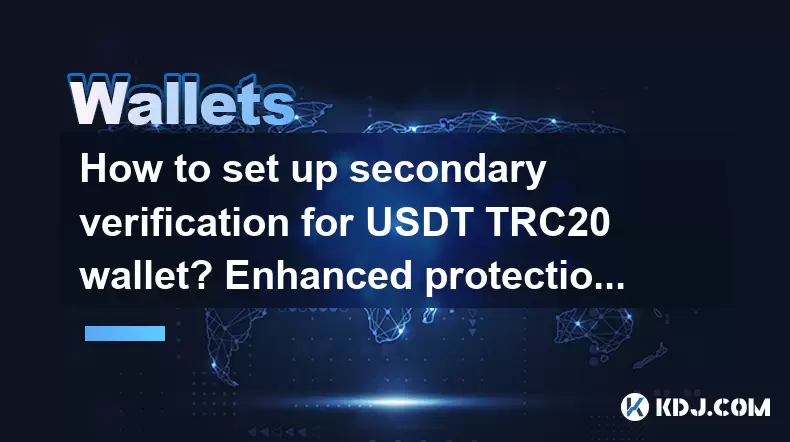
How to set up secondary verification for USDT TRC20 wallet? Enhanced protection
Jun 12,2025 at 12:07pm
Understanding USDT TRC20 Wallets and Security NeedsWith the increasing popularity of Tether (USDT) on the TRON (TRC20) network, securing digital assets has become a critical concern for users. A USDT TRC20 wallet is essentially a blockchain wallet that supports the TRC20 protocol, allowing users to store, send, and receive USDT tokens. Given the volatil...

How to use USDT TRC20 wallet anonymously? Privacy protection guide
Jun 12,2025 at 11:35pm
Understanding USDT TRC20 and Its Privacy ImplicationsUSDT TRC20 refers to the Tether (USDT) cryptocurrency that operates on the TRON blockchain. Unlike its Ethereum-based ERC20 counterpart, TRC20 offers faster transactions and lower fees. However, despite these advantages, privacy remains a significant concern for many users who wish to transact anonymo...
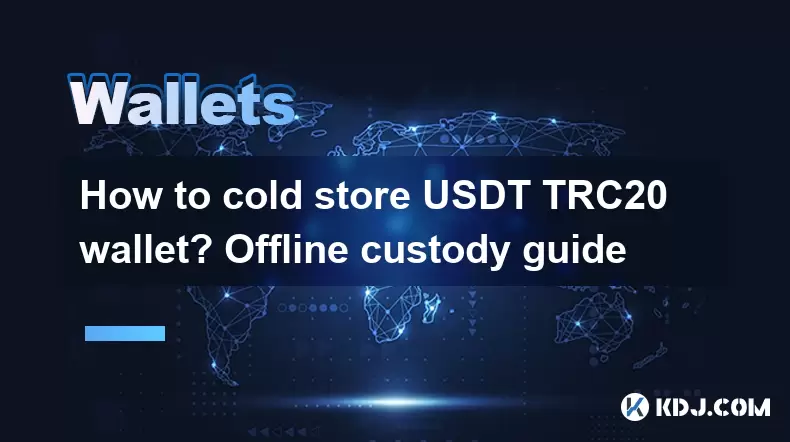
How to cold store USDT TRC20 wallet? Offline custody guide
Jun 11,2025 at 09:36pm
Understanding USDT TRC20 and Cold StorageUSDT (Tether) is a stablecoin pegged to the value of the U.S. dollar, offering stability in the volatile cryptocurrency market. TRC20 refers to the technical standard used for smart contracts on the Tron blockchain, which is different from Ethereum's ERC-20. When it comes to securing your USDT TRC20 tokens, cold ...

How to export USDT TRC20 private key? Security operation guide
Jun 11,2025 at 07:08pm
Understanding USDT TRC20 and Private KeysTether (USDT) is one of the most widely used stablecoins in the cryptocurrency market. The TRC20 version of USDT operates on the TRON blockchain, offering faster transaction speeds and lower fees compared to its ERC-20 counterpart on Ethereum. When you hold USDT TRC20, your ownership is secured through a private ...
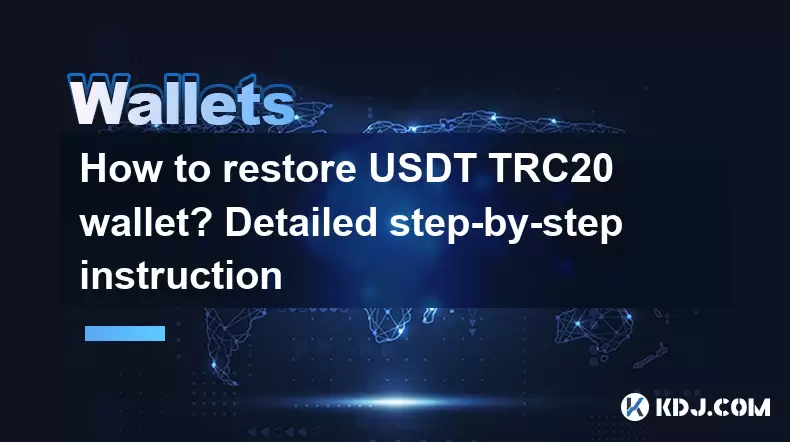
How to restore USDT TRC20 wallet? Detailed step-by-step instruction
Jun 12,2025 at 06:56am
Understanding the USDT TRC20 Wallet Restoration ProcessRestoring a USDT TRC20 wallet typically involves retrieving access to your digital assets using either a private key, a seed phrase, or a wallet address. This process is crucial for users who have lost access to their wallets due to device changes, software issues, or accidental deletion. The TRC20 ...
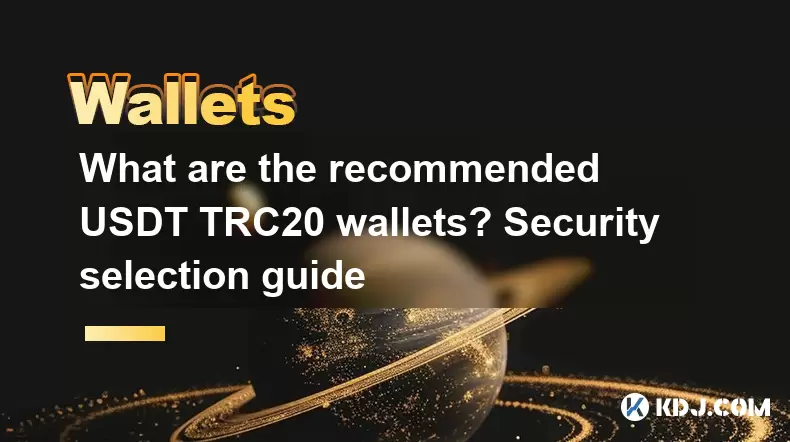
What are the recommended USDT TRC20 wallets? Security selection guide
Jun 12,2025 at 06:42pm
Understanding USDT TRC20 and Wallet CompatibilityUSDT TRC20 is a version of the Tether stablecoin that operates on the TRON blockchain. Unlike the ERC-20 variant which runs on Ethereum, TRC20 offers lower transaction fees and faster confirmation times, making it popular among traders and users who frequently transact in USDT. To store and manage USDT TR...

How to set up secondary verification for USDT TRC20 wallet? Enhanced protection
Jun 12,2025 at 12:07pm
Understanding USDT TRC20 Wallets and Security NeedsWith the increasing popularity of Tether (USDT) on the TRON (TRC20) network, securing digital assets has become a critical concern for users. A USDT TRC20 wallet is essentially a blockchain wallet that supports the TRC20 protocol, allowing users to store, send, and receive USDT tokens. Given the volatil...

How to use USDT TRC20 wallet anonymously? Privacy protection guide
Jun 12,2025 at 11:35pm
Understanding USDT TRC20 and Its Privacy ImplicationsUSDT TRC20 refers to the Tether (USDT) cryptocurrency that operates on the TRON blockchain. Unlike its Ethereum-based ERC20 counterpart, TRC20 offers faster transactions and lower fees. However, despite these advantages, privacy remains a significant concern for many users who wish to transact anonymo...

How to cold store USDT TRC20 wallet? Offline custody guide
Jun 11,2025 at 09:36pm
Understanding USDT TRC20 and Cold StorageUSDT (Tether) is a stablecoin pegged to the value of the U.S. dollar, offering stability in the volatile cryptocurrency market. TRC20 refers to the technical standard used for smart contracts on the Tron blockchain, which is different from Ethereum's ERC-20. When it comes to securing your USDT TRC20 tokens, cold ...

How to export USDT TRC20 private key? Security operation guide
Jun 11,2025 at 07:08pm
Understanding USDT TRC20 and Private KeysTether (USDT) is one of the most widely used stablecoins in the cryptocurrency market. The TRC20 version of USDT operates on the TRON blockchain, offering faster transaction speeds and lower fees compared to its ERC-20 counterpart on Ethereum. When you hold USDT TRC20, your ownership is secured through a private ...

How to restore USDT TRC20 wallet? Detailed step-by-step instruction
Jun 12,2025 at 06:56am
Understanding the USDT TRC20 Wallet Restoration ProcessRestoring a USDT TRC20 wallet typically involves retrieving access to your digital assets using either a private key, a seed phrase, or a wallet address. This process is crucial for users who have lost access to their wallets due to device changes, software issues, or accidental deletion. The TRC20 ...

What are the recommended USDT TRC20 wallets? Security selection guide
Jun 12,2025 at 06:42pm
Understanding USDT TRC20 and Wallet CompatibilityUSDT TRC20 is a version of the Tether stablecoin that operates on the TRON blockchain. Unlike the ERC-20 variant which runs on Ethereum, TRC20 offers lower transaction fees and faster confirmation times, making it popular among traders and users who frequently transact in USDT. To store and manage USDT TR...
See all articles

























































































